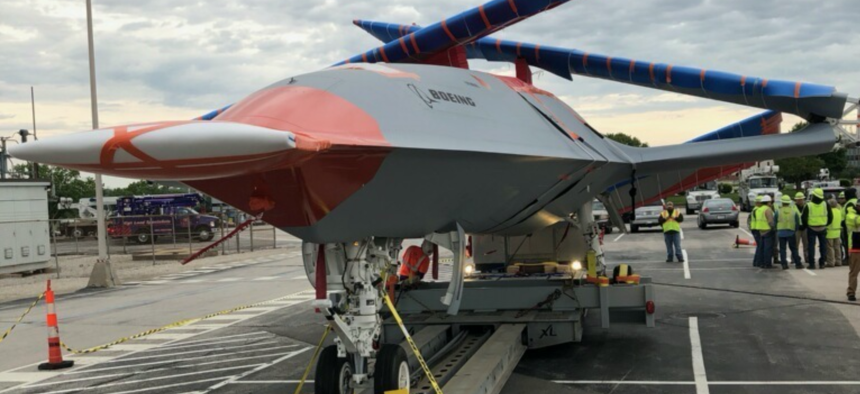
A prototype of the Navy’s new MQ-25 carrier-based drone is driven to its test airfield in Illinois. Boeing
Here's the US Navy’s Drone Tanker, on the Road
A test prototype of Boeing’s MQ-25 carrier-based refueling aircraft gets a ride to its test airfield.
A prototype of the Navy’s new MQ-25 carrier-based drone is expected to fly before year’s end, but it’s already taken a drive on the highway.
On Sunday night, a gray test drone about the size of a F/A-18 Super Hornet fighter jet was loaded on a flatbed semi truck and driven from Boeing’s campus at St. Louis Lambert International Airport across the Mississippi River to MidAmerica St. Louis Airport, a small regional airport next to Scott Air Force Base in rural Illinois.
Since the regional airport is in less crowded airspace, “it gives us some flexibility in how we can fly,” Dave Bujold, the Boeing program manager overseeing drone project, said in an interview on Monday.
In the coming years, Boeing will build four MQ-25 drones for the Navy. The Navy intends to fly the drones from aircraft carriers, using them to refuel other aircraft mid-flight. The drone will not carry weapons.
The drone moved on Sunday night, is a test aircraft built by Boeing on its own dime. Within the company, it’s known as T-1 or “Tail 1.”
Boeing has designed the plane entirely with digital tools, “a feature that allows us to have a common virtual environment where we can review design together.” The company also digitally designed its T-X training jet, a plane that went from concept to flight in one year.
“The objective of use of this aircraft is early learning for” the first Navy aircraft, Bujold said. “So every flight test mission that we do with out Boeing asset allows us to pull faster data, better understanding, software development and all that for the Navy aircraft,” he said. “So when the Navy’s first combat-built...aircraft will fly, we will have already been flying the same airframe, weight and class.”
While the company is planning to fly the test drone before year’s end, a lot still needs to happen before hand. First, the testing team needs to get used to its new home in Illinois, about 40 miles west of Lambert. Ground control stations must be installed.
The MQ-25 test aircraft already sports orange paint on its nose and wings, common markings for aircraft in flight testing. Before flying, it must pass a series of ground taxiing tests. Also, the Federal Aviation Administration must certify the aircraft and grant clear airspace for it to fly.
Bujold described the test flights — scheduled to begin later this year — as “the classic flight test work,” expanding the drone’s envelope.
When that’s done, the plane will undergo modifications including the installation of the aerial refueling system and new electronics. When that’s done, the plane will start flying again.
The Boeing test aircraft will eventually undergo testing on the East Coast, where the Navy will hoist it onto an aircraft carrier for deck handling testing.
“By the time the Navy’s assets are jumping in the air, we will already have had thousands of test hours on the ground and hundreds in the air,” Bujold said.
The first Navy aircraft is scheduled to fly in fiscal 2021.
“We’re on pace [to meet that schedule],” Bujold said. “In the meantime, we’ll fly this [prototype] and learn a lot early.”
The project is moving quickly, particularly by Pentagon standards, for several reasons. First, Boeing had already designed and built a prototype of the autonomous drone. So when the Navy ordered four MQ-25s in September, the company was able to start preparing the prototype for flight.
Another reason the project is moving quickly: a team of Navy officials is based inside of Boeing’s St. Louis program office. Traditionally, the contractors and government officials are at different locations and only meet occasionally. Now Navy officials are embedded with Boeing.
“That really affords quick decision making, face-to-face contact,” Bujold said. “There’s no meeting that is closed there. They’re invited to any of our day-to-day execution. Alternatively, they’re empowered so they can make decisions without us spending a lot of time back and forth over [formal] communications. That allows us to execute quicker and turn things.”
New authorities from Congress and policies at the Pentagon have allowed top officials to delegate more decision-making authorities down to program managers in the field.
“We view it as extremely enabling for communication and for interaction,” Bujold siad. “It builds that speed to decision that’s really characterized by how this program is going to execute throughout the phases.”
Bujold is able to walk into his Navy counterpart’s office and ask a question and get an immediate answer. This is saving days — even weeks — from previous programs.
NEXT STORY: One Defense Agency is Building a Bot Army




